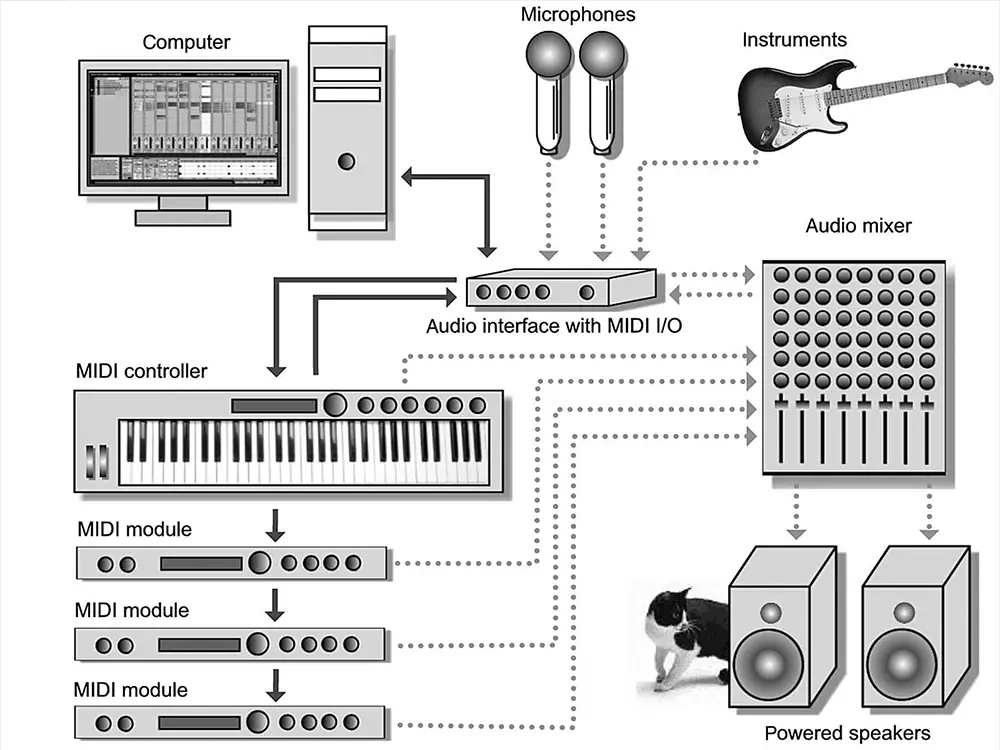Compression File Formats
Compressed files use file compression in order to save disk space.
Compressed archive formats can also be used to compress multiple files into a single archive.
Several open and proprietary compression algorithms can be used to compress files, which is why many different compressed file types exist.
Common compressed file extensions include .ZIP, .SITX, .7Z, .RAR, and .GZ.
Common compressed file extensions include .ZIP, .SITX, .7Z, .RAR, and .GZ.
What is Midi?
Simply stated, Musical Instrument Digital Interface (MIDI) is a digital communications language and compatible specification that allows multiple hardware and software electronic instruments, performance controllers, computers, and other related devices to communicate with each other
over a connected network (Figure 8.6).
MIDI is used to translate performance- or control-relate events (such as playing a keyboard, selecting a patch number, varying a modulation wheel, triggering a staged visual effect, etc.) into equivalent digital messages and then transmit these messages to other MIDI devices where they can be used to control sound generators and other performance parameters.
The beauty of MIDI is that its data can be recorded into a hardware device or software program (known as a sequencer), where it can be edited and transmitted to electronic instruments or other devices to create music or control any number of parameters. In artistic terms, this digital language is an important medium that lets artists express themselves with a degree of flexibility and control that, before its inception, wasn’t possible on an individual level. Through the transmission of this performance language, an electronic musician can create and develop a song or composition in a practical, flexible, affordable, and fun production environment.
The beauty of MIDI is that its data can be recorded into a hardware device or software program (known as a sequencer), where it can be edited and transmitted to electronic instruments or other devices to create music or control any number of parameters. In artistic terms, this digital language is an important medium that lets artists express themselves with a degree of flexibility and control that, before its inception, wasn’t possible on an individual level. Through the transmission of this performance language, an electronic musician can create and develop a song or composition in a practical, flexible, affordable, and fun production environment.

Audio
The use of recordings as a means of experimenting with sound began with the composer Edgard Varese, who created
collages of music and sound in the 1920s and 1930s, recording on multiple disks and, later, tape recorders.
The exploration of music and sound through the cutting, splicing, and layering of tape was called "musique
concrete", with echoes now in contemporary techno and gorilla rap. Still another turning point in the manipulation of electronic sound was the first commercially produced electronic synthesizers, created by Robert Moog and others in the 1960s. The Moog analog synthesizer ultimately led to the digital instruments of the 1980s, specifically the establishment of MIDI (musical instrument digital interface), the standard protocol for connecting digital music
hardware and software. Various digital audio editing software soon followed, as well as the development of
multitrack recording/editing environments, which allow the designer to layer multiple audio tracks, much as
graphic designers layer images.
| MIDI | The standard file format supported by Macintosh and Windows/NT for transmitting information between computers and digital devices that simulate musical instruments. |
| Zip | The popular file format supported by Windows/NT and Macintosh for compressing data and zipping and unzipping files. |
| WAV | The standard PC file format that stores sound in files built into Windows. The files also take up a large amount of disk space. |
| AVI | The file format developed by Microsoft that is the most common format for full motion video and animation with sound on the PC. |
| SIT | The shareware file format that stuffs files onto multiple floppies and is a standard on Macintosh. |
| MP3 | The file format supported by Windows/NT and Macintosh that compresses audio files and provides the same fidelity as a CD. |